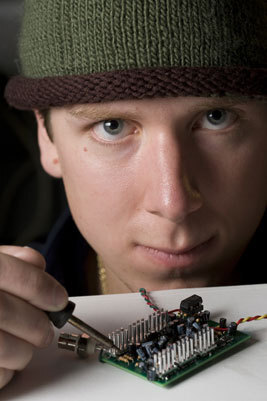by
Joan Trombetti, Writer | January 26, 2009

George Lewis
Robert Barker/
University Photography
Cornell grad student George Lewis has developed a prototype of a therapeutic ultrasound device that is palm-sized, battery-powered and as transducers go can deliver sound waves that are strong enough to cause water to bubble, spray and turn into steam.
A third-year Ph.D. student in biomedical engineering and a National Science Foundation fellow, Lewis creates ultrasound devices that are smaller, more powerful and many times less expensive than today's models.
The ultrasound device that Lewis built is pocket-sized and cost him $100 to build. Many of the portable ultrasound models now manufactured weigh several pounds and can cost upwards of $20,000. Lewis envisions a world where therapeutic ultrasound machines are found in every hospital and medical research lab.
The higher-energy ultrasound that Lewis works with can treat such conditions as prostate tumors or kidney stones by breaking them up and can also relieve arthritis pressure and help treat brain cancer by pushing drugs quickly through the brain following surgery.
Lewis suggests that his technology could lead to such innovations as cell phone-size devices that military medics could carry to cauterize bleeding wounds, or dental machines to enable the body to instantly absorb locally injected anesthetic.
Lewis miniaturized the ultrasound device by increasing its efficiency. Traditional devices apply 500-volt signals across a transducer to convert the voltage to sound waves, but in the process, about half the energy is lost. In the laboratory, Lewis has devised a way to transfer 95 percent of the source energy to the transducer.
His new devices are currently being tested in a clinical setting at Weill Cornell Medical College.
